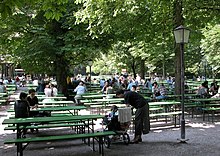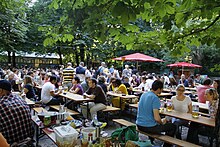Beer garden
The beer garden (also beer cellar and "on the beer cellar") arose from the dispensing of beer through the brewing of a beer cellar without to operate a tavern required Krug law . The serving from the cellars was officially approved for the first time in 1812 in the Isar district , later in Upper Bavaria . This emergence shapes the existing appearance of a traditional beer garden in Bavaria , in which the guest sits under shady trees and is allowed to bring his own food.
In a broader sense, the term “beer garden” is also used for other outdoor dining establishments, which in Bavaria and Austria are called pub gardens or guest gardens .
development

Beer gardens emerged in Bavaria in the 19th century in Munich , when mainly bottom-fermented beer was drunk. This could only be produced in the cold months, as fermentation had to take place at temperatures between four and eight degrees (as did storage - the unpasteurized beer quickly turned bad at higher temperatures). In order to store beer over the summer, Munich brewers built deep beer cellars in the river terraces of the Isar , in which the beer could be kept cool with ice all year round. Hence the concentration of beer gardens on the Schwanthalerhöhe and in Haidhausen . In order to lower the average temperature of the camp even further, gravel was spread on the floor of the slope and chestnuts were planted , which provide shade in summer. In addition, the flat roots of the chestnuts did not damage the cellar vault.
Until 1799, however, it was mostly forbidden for Munich brewers to serve beer in their storage cellars. Similar to Strauss taverns , they were only allowed to dispense beer directly during the summer beer serving time, indicated by a green wreath. For this purpose, simple benches and tables were placed under the trees. These places soon became a popular excursion destination for Munich residents, much to the annoyance of the smaller brewers who stayed in Munich. In order to counteract the increasing emigration of guests, they approached King Maximilian I via the General Commissioner of the Isar District, who decreed in a rescript of January 4, 1812 that the beer cellars in the Isar District around Munich would continue serving, but no food except bread were allowed to serve.
“The local brewers should be allowed to wear their own Merzenbier in Minuto in their own March cellars in June, July, August and September , and their guests there with beer etc. Brod to use. However, they are expressly prohibited from serving food and other drinks. "
Of these cellar beer gardens , the Augustiner cellar , the Paulaner am Nockherberg and the Hofbräukeller are still preserved. The cellars of Bürgerbräukeller and Franziskaner now form the underground car parks of the Motorama and Franziskanerhof complexes.
In 1825, the Bavarian trade law was liberalized, so that until now pure bar establishments obtained the right to serve food. At the same time, the large public gardens and parks in Munich were expanded during the Biedermeier period . This resulted in a large number of garden taverns in the city and outside the walls, which became popular excursion destinations. Some emerged from hunting and forest houses, others from post offices or Schwaigen . In front of the city “dance halls, entertainment areas, bowling alleys, carousels, arcades, secluded arbors and shady groups of trees” were built. As a result, the difference between the traditional cellar and garden taverns became blurred. In the meantime, innkeepers all over Germany and also in tourist regions all over the world refer to outdoor bar areas as “beer gardens”.
The tradition that guests bring their own snack to the beer garden and only buy the drinks has been preserved, especially in Upper Bavaria around Munich and in beer Franconia , and occasionally in the (temporarily Bavarian) Austrian Salzburg. There is sometimes an area of the garden where at the table served is and where no own snacks may be brought. In the actual beer garden area, which is often set off by other tables - mostly beer sets - you can eat food you have brought with you or bought in the beer garden. In addition to a bar for drinks, depending on the size of the beer garden, there is usually one or more stalls selling simple dishes such as pretzels , radishes , fruit or sausage salad , sometimes also warm dishes such as chicken or fish on a stick .
meaning
The Bavarian State Government assigns the traditional beer garden an important social function in the Bavarian Beer Garden Ordinance. Beer gardens are a “popular meeting place for broad sections of society” and make it possible to overcome social differences. Since the government sees the beer gardens as a local recreational goal for the densely populated areas, the Beer Garden Ordinance defines some exceptions for traditional beer gardens with regard to night rest and noise protection.
In the context of the debates about the beer gardens that led to the Bavarian Beer Garden Ordinance, folklorist Birgit Speckle points out that the idea of overcoming social differences, sociable beer enjoyment was a popular stereotype of the 19th century. However, this would hide breaks and draw illogical conclusions. However, this contrasts with contemporary sources in which visitors to Munich from outside or newcomers report on how Munich residents communicate at the beer table across all class boundaries. For the Biedermeier period one can see that it was different in Munich than in other German cities or Vienna, so that folklorist Volker D. Laturell speaks of the "blurring of class differences in taverns or beer gardens". With sources from the 19th century, however, he restricts this to the bourgeoisie and the working class, the upper class was only represented on special occasions such as garden parties.
Well-known beer gardens in and around Munich

The largest traditional beer garden in the world is the Munich Hirschgarten . The beer garden, which is best known to Munich residents and tourists and is also the second largest, is located in the English Garden by the Chinese Tower . A beer garden is located in the center of town in the Viktualienmarkt . The beer garden on the Nockherberg has become known nationwide thanks to Paulaner TV advertising.
In the district of Munich are the Kugler Alm near Oberhaching , which claims the invention of the cyclist , and the forest management near Pullach , which became known nationwide through the beer garden revolution, because the beer garden ordinance and the definition of a traditional beer garden based on the disputes over noise protection in their neighborhood were developed.
Beer gardens belonging to monasteries such as Andechs Monastery and Weltenburg Monastery are known . There the brewery and beer garden are often located in the immediate vicinity.
literature
- Georg Ferdinand Döllinger: The brewing industry, brandy distilling and the malt surcharge in the Kingdom of Bavaria in a police and cameralistic relationship. CH Beck, Nördlingen 1850, OCLC 162796066 .
- Cordula Loidl-Reisch: Guest gardens as objects of monument preservation. From discussing the possibility of regulation to unexpected biographical references . In: Die Gartenkunst 19 (2/2007), pp. 325–328.
Web links
- Bavarian Beer Garden Ordinance
- Beer gardens all over Germany
- Beer gardens in and around Munich
- History of the Bavarian beer gardens: In the shadow of the chestnut. In: the daily newspaper. May 26, 2012.
- Albert Schäffer: 120 minutes are not enough , Frankfurter Allgemeine Zeitung, May 14, 2012
Individual evidence
- ↑ a b Excerpt from the justification for the Bavarian Beer Garden Ordinance (PDF; 22 kB) of April 20, 1999: “The Bavarian beer garden is characterized by two main features: the garden character and the traditional form of operation, especially the possibility of being there You can also consume your own snack you have brought with you free of charge, which sets it apart from other outdoor restaurants. "
- ^ Astrid Assel, Christian Huber: Munich and beer . Volk Verlag, 2009, ISBN 978-3-937200-59-0 , pp. 76-80.
- ^ Volker D. Laturell : Popular culture in Munich . Buchendorfer, 1997, ISBN 3-927984-63-9 , pp. 57, 62.
- ↑ 120 minutes is not enough. In: Frankfurter Allgemeine Zeitung. May 22, 2012, p. 7.
- ↑ Volker D. Laturell: Volkskultur in München , pp. 52, 56.
- ^ Volker Laturell: Folk culture in Munich. Buchendorfer, 1997, ISBN 3-927984-63-9 , pp. 122, 124.
- ^ Volker Laturell: Folk culture in Munich. Buchendorfer, 1997, ISBN 3-927984-63-9 , p. 127.
- ↑ Beer gardens and breweries in Salzburg : Augustiner Bräustübl / Müllner Bräu. visit-salzburg.net (accessed February 12, 2016).
- ↑ Birgit Speckle: Dispute about beer in Bavaria: moral concepts about purity, community and tradition . Volume 27 of Munich University Writings: Munich Contributions to Folklore, Waxmann Verlag, Munich 2001, p. 185.
- ^ Marianne Bernhard: The Biedermeier. Econ, 1983, ISBN 3-430-11313-X , p. 177.
- ^ Volker Laturell: Folk culture in Munich. Buchendorfer, 1997, ISBN 3-927984-63-9 , p. 144 f.



